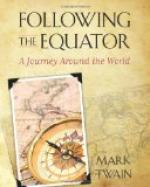“As an instance of the heavy firing brought to bear on our position this month may be mentioned the cutting down of the upper story of a brick building simply by musketry firring. This building was in a most exposed position. All the shots which just missed the top of the rampart cut into the dead wall pretty much in a straight line, and at length cut right through and brought the upper story tumbling down. The upper structure on the top of the brigade-mess also fell in. The Residency house was a wreck. Captain Anderson’s post had long ago been knocked down, and Innes’ post also fell in. These two were riddled with round shot. As many as 200 were picked up by Colonel Masters.”
The exhausted garrison fought doggedly on all through the next month October. Then, November 2d, news came Sir Colin Campbell’s relieving force would soon be on its way from Cawnpore.
On the 12th the boom of his guns was heard.
On the 13th the sounds came nearer—he was slowly, but steadily, cutting his way through, storming one stronghold after another.
On the 14th he captured the Martiniere College, and ran up the British flag there. It was seen from the Residency.
Next he took the Dilkoosha.
On the 17th he took the former mess-house of the 32d regiment—a fortified building, and very strong. “A most exciting, anxious day,” writes Lady Inglis in her diary. “About 4 P.M., two strange officers walked through our yard, leading their horses”—and by that sign she knew that communication was established between the forces, that the relief was real, this time, and that the long siege of Lucknow was ended.
The last eight or ten miles of Sir Colin Campbell’s march was through seas of, blood. The weapon mainly used was the bayonet, the fighting was desperate. The way was mile-stoned with detached strong buildings of stone, fortified, and heavily garrisoned, and these had to be taken by assault. Neither side asked for quarter, and neither gave it. At the Secundrabagh, where nearly two thousand of the enemy occupied a great stone house in a garden, the work of slaughter was continued until every man was killed. That is a sample of the character of that devastating march.
There were but few trees in the plain at that time, and from the Residency the progress of the march, step by step, victory by victory, could be noted; the ascending clouds of battle-smoke marked the way to the eye, and the thunder of the guns marked it to the ear.
Sir Colin Campbell had not come to Lucknow to hold it, but to save the occupants of the Residency, and bring them away. Four or five days after his arrival the secret evacuation by the troops took place, in the middle of a dark night, by the principal gate, (the Bailie Guard). The two hundred women and two hundred and fifty children had been previously removed. Captain Birch says:




